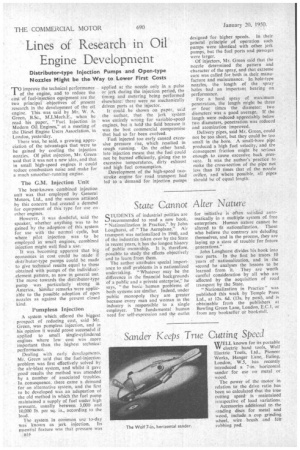Lines of Research in Oil Engine Development
Page 50

If you've noticed an error in this article please click here to report it so we can fix it.
Distributor-type Injection Pumps and Open-type Nozzles Might be the Way to Lower First Costs
To improve the technical performance of the engine, and to • reduce the cost of fuel-injection equipment are the, two principal objectives of present research in the development of the oil engine. This was said by Mr. W. A. Green, .B.Sc., M.I.Mech.E., when he read his paper," Fuel Injection in Modern Oil Engines," at a meeting of the Diesel Engine Users Association, in London, yesterday.
There was, he said, a growing appreciation of the advantages that were to be gained by cooling the injection nozzles. Of pilot injection, Mr. Green said that it was not a new idea, and that in small high-speed engines it could reduce combustion noise and make for a much smoother-running engine,
The QM. Injection Unit The best-known combined injection unit was that employed by General Motors, Ltd., and the success attained by this concern had created a den-ernd for equipment of this type for use on ether engines.
However, it was doubtful, said the speaker, whether anything was to be gained by the adoption of this system for use with the normal e cycle, but where pilot injection was to be employed in small engines, combined injection might well find a use..
It was becoming apparent that big economies in cost could be made if distributor-type pumps could be made to give technical results equal to those obtained with pumps of the individualelement pattern, as now in general use. The move towards the distributor-type pump was particularly strong in America, Similar remarks were applicable to the possible adoption of open nozzles as against the present closed kind.
Pumpless Injection
A system which offered the biggest prospect of reducing cost, said Mr. Green, was pumpless injection, and in his opinion it would prove successful if applied to small single-cylindered engines where low cost was more important than the highest technical performance.
Dealing with early developments, Mr. Green said that the fuel-injection problem was first effectively solved by the air-bIaSt system, and whilst it gave goodresults the method was attended by a number of associated troubles. In consequence, there came a demand for an alternative system, and the first to be developed was an adaptation of the old method in which the fuel pump maintained a supply of fuel under high pressure, usually between 3,000 and 10,000 lb. per sq. in., according to the load.
The system in common use to-day was known as jerk injection. Its essential feature was that pressure was F116 applied at the nozzle only in a pulse or jerk during the injection period, the timing and metering being performed elsewhere: there were no mechanically driven parts at the injector.
It could be shown on paper, said the author, that the jerk system was entirely wrong for variable-speed engines, but it held the field because it was the best commercial compromise that had so far been evolved.
Fuel injected too early caused excessive pressure rise, which resulted in rough running. On the other hand. late injection meant that the fuel could not be burned efficiently, giving rise to excessive temperatures, dirty exhaust and high fuel consumption.
Development of the high-speed twostroke engine for road transport had led to a demand for injection pumps
designed for higher speeds. In their general. principle ,of operation such pumps were identical with other jerk pumps, but the fuel ports and passages were larger.
Of injectors, Mr. Green said that the nozzle determined the pattern and character of the spray, and that extreme care was called for, both in their manufacture and maintenance. inhale-type nozzles, the length of the spray holes had an important bearing on performance.
For a hard spray of maximum penetration, the length might be three or four times the diameter: two diameters" was a good average. If the length were reduced appreciably below two diameters, penetration was reduced and atomization improved.
Delivery pipes, said Mr. Green, could not be too short, hut they could be too small in the bore. A small-bore pipe produced a high fuel velocity, and the consequent friction might be serious enough to cause excessive back pressure. It was the author's practice to make the cross-section of the pipe not less than 10 times that of the nozzle orifice, and where possible, all pipes should be of equal length.




















































































